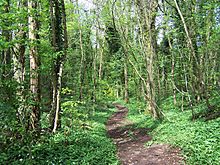Shorn Cliff and Caswell Woods facts for kids
| Site of Special Scientific Interest | |

Caswell Woods
|
|
| Area of Search | Gloucestershire |
|---|---|
| Grid reference | & |
| Coordinates | 51°42′06″N 2°39′59″W / 51.7018°N 2.666306°W |
| Interest | Biological |
| Area | 69.2 hectare |
| Notification | 1986 |
Shorn Cliff And Caswell Woods is a very special natural area in Gloucestershire, England. It covers about 69.2-hectare (171-acre) of land. This area was officially recognized in 1986 as a Site of Special Scientific Interest (SSSI). This means it's a place protected by law because of its important plants, animals, or geology.
The woods are also listed as a Key Wildlife Site (KWS) in the 'Forest of Dean Local Plan Review'. This shows how important it is for nature. You can find Shorn Cliff and Caswell Woods in the famous Forest of Dean and the beautiful Wye Valley Area of Outstanding Natural Beauty. An Area of Outstanding Natural Beauty (AONB) is a special landscape protected for its natural beauty.
Both the cliff and the woods are made of Carboniferous Limestone. They are on the eastern side of the Lower Wye Gorge, which is also an SSSI. This whole area forms a long stretch of woodland from Brockweir to Tutshill. The woodlands in the lower Wye Valley are among the most important in Great Britain for protecting nature. They are surrounded by other natural areas and untouched grasslands, which makes this part of southern Britain very rich in wildlife.
The Wye Valley Woodlands are also known as a Special Area of Conservation (SAC). This is an even higher level of protection under European rules, meaning they are very important for rare habitats and species.
What Plants Grow Here?
This special site is home to many different kinds of trees and some rare plants. On the higher parts of the slopes, you'll find lots of Beech trees. Many of these are very old and have been managed using a method called coppicing. Coppicing involves cutting trees down to the base to encourage new shoots, which helps them live longer.
Where the soil has more limestone, you can see trees like Small-leaved lime, Ash, and Yew. On soils that are more acidic, you'll find Silver birch and Oak trees. In very old woodlands, the ground usually doesn't have many plants because the tree canopy blocks out the light. Here, you might mostly see Common ivy and plants like Spurge laurel. But in areas where trees have been coppiced, more light gets through, allowing a thicker layer of plants to grow on the ground.
On the lower slopes, there are woodlands mainly made of coppiced ash and small-leaved lime trees. You might also spot Field Maple trees and shrubs like Hazel, Wayfaring-tree, and Guelder-rose. This area is also rich in ferns, such as Hart's-tongue, Soft Shield-fern, and Hard Shield-fern. In the wetter parts near the River Wye (which is also an SSSI), especially in Caswell Wood, you can find Alder trees.
There are also paths through the woods called woodland rides. These paths get more sunlight and support different kinds of plants. Springs and wet spots on the lower slopes of Shorn Cliff Woods create perfect conditions for plants that love damp places. These include Great Horsetail, Hemp Agrimony, and Pendulous Sedge.
Some very rare plants grow here too. These include the nationally rare Wood Fescue and Narrow-leaved Bitter-cress. You can also find local rarities like Wood-rush (Luzula forsteri), Wild Madder, Lily-of-the-valley, and Tutsan. Nearby, in a woodland called Lippets Grove, you might even find the beautiful Martagon Lily. Lippets Grove is a nature reserve managed by the Gloucestershire Wildlife Trust and can be reached by following the Offa's Dyke Path.
What Animals Live Here?
The bare limestone rocks at Shorn Cliff and Caswell Woods are important for birds. They are a known breeding area for birds like the Kestrel. Kestrels are birds of prey, known for hovering in the air while looking for food.

